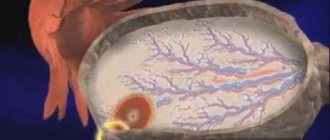A menstrual cycle that lasts from 21 to 33 days is considered normal. But not all women can boast that their monthly discharge appears exactly on time. Delayed periods and pain in the lower abdomen are most often the first signs of pregnancy. But sometimes these are symptoms of health problems.
In order not to get lost in guesswork and worry in vain, experts advise taking a pregnancy test. If the result is positive, most women feel some discomfort and nagging pain. If the test result refutes pregnancy, then you should not postpone your visit to the gynecologist. Delay accompanied by pain can be associated with many pathologies, as well as stress, severe physical exertion, climate change or a common cold.
Characteristics of the norm
When the discharge is brown in color for up to three days, there is no reason to worry. For many women, spotting begins shortly before menstruation, gradually acquiring the features of natural bleeding characteristic of the regulation.
Pathology should not be suspected if the following characteristics of secretion occur:
- homogeneous consistency (small clots);
- reddish or brown tint;
- insignificant volume (daily days are enough);
- absence of itching and burning;
- no unpleasant odor;
- occurs a few days before menstruation;
- Not every cycle is noted.
The main factor in the appearance of brown discharge with blood instead of menstruation is a hormonal imbalance. It can be provoked by the woman herself. Certain conditions can affect the functioning of the reproductive system.
What does vaginal discharge and nagging pain in the lower abdomen tell you about?
Any specific symptoms alert a person. If a woman has pain in her lower abdomen and the discharge is of an unusual nature, the first person she will turn to will be a gynecologist. Despite the fact that these signs are quite common in the case of diseases of the genital area, there are other possible options that are normal.
Causes of abdominal pain in women
Painful sensations in the abdominal area themselves cannot be considered as a symptom of a specific disease, since they are present in a wide variety of cases. As a rule, these are problems with the functioning of the pelvic organs or inflammatory and infectious processes occurring in it.
To exclude any surgical pathologies that are life-threatening, it is better to consult a doctor in a timely manner for advice. Diagnosis will require not only the results of tests and examinations, but also a description of the localization and intensity of pain, which largely narrows the range of possible causes of this disease. Associated symptoms are also of great importance.
Among the most common pathological conditions that cause various types of pain in the abdominal area are the following:
- inflammatory process in the genitals - this condition is characterized by dull pain and bleeding not associated with menstruation;
- infectious disease - characterized by elevated body temperature and vaginal secretion of a pathological nature;
- genitourinary disease - supplemented by blood discharge during urination;
- gastrointestinal disturbances – accompanied by nausea, vomiting, intestinal upset;
- appendicitis - severe interval pain in the peritoneum, localized on the right side, with elevated temperature.
The frequency and duration of such sensations is also important. Their exact characteristics are needed to determine the course of the disease (acute or chronic). Attacks of pain may indicate an exacerbation of a chronic disease.
When pain is accompanied by unusual vaginal discharge, to accurately diagnose it, it is necessary to indicate the color of the secretion, smell and consistency. Often these signs point the specialist to the most likely problem and seriously narrow the list of necessary studies.
When the lower abdomen hurts and there is bloody discharge (red, brown and pink)
Discharge with blood can be a sign of both completely natural processes and a consequence of pathology. The first case includes the following:
- The beginning of menstruation.
- Bloody discharge after menstruation a week or two later, approximately in the middle of the cycle, may be the result of a ruptured follicle, which is a normal process for this period.
- When menstruation is delayed, brown discharge with pain in the lower abdomen may appear as a result of the implantation of the fertilized egg into the uterus. This phenomenon is called implantation bleeding. The volume of fluid released is small, reminiscent of the beginning or end of regulation.
- During the postpartum period.
- Surgical intervention on the uterus (abortion, curettage, etc.).
- Taking hormonal medications (may cause the symptoms in question between menstrual periods).
- Microcracks in the vaginal mucosa after sexual intercourse cause a change in the color of the sexual secretion due to droplets of blood, which can also give a brown color.
- Nagging pain sometimes appears after the first sexual intercourse.
- Pink vaginal discharge with aching pain is one of the initial signs of the onset of menstruation. Girls who have not had it yet need to prepare for the appearance of blood after a few hours, i.e. buy hygiene products (pads).
A number of diseases of a woman’s reproductive organs cause bloody mucus or dark brown discharge before or after menstruation, accompanied by nagging abdominal pain (endometriosis, endometrial polyps, uterine fibroids, ovarian cysts) . These include endometritis, polyps, endometrial hyperplasia, cervical ectopia, uterine fibroids, ovarian cysts, etc. Ectopic pregnancy and hormonal imbalance lead to the same phenomena.
If there is a white discharge and a tummy tug
Such secretion without additional unpleasant symptoms usually does not pose any danger. This is the so-called leucorrhoea, which should be present as vaginal secretion of every healthy woman. If copious mucus is accompanied by other discomfort, you should consult a doctor for further examination.
White, copious discharge with a cheesy consistency is usually a sign of thrush. At the same time, the smell of discharge from thrush has an unpleasant sour note, and additional symptoms include itching, burning, irritation and swelling in the vagina.
Such pathogenic mucus can also be a consequence of bacterial infections that are caused by harmful microorganisms. The balance of microflora in a woman’s vagina can be disrupted due to taking antibiotics, climate change, stress or hormonal imbalances.
Clear, copious discharge with pain radiating to the back
In the middle of the cycle, women ovulate. It is accompanied by the release of the egg. This process is characterized by mild pain and a change in the nature of the sexual secretion.
During ovulation, the secretion acquires a more mucilaginous consistency and the discharge becomes similar to egg white. To describe the sign, women use the expression “like snot.”
An admixture of whitish or bloody discharge is considered normal. This symptom, along with unpleasant sensations, lasts about 2-3 days.
Pain after ovulation often becomes a sign of inflammation of the appendages (adnexitis).
Liquid discharge in the middle of the cycle with nagging pain often indicates the beginning of ovulation. Before the secretion becomes mucoid, it becomes thin like water. This is a sign of the natural course of the menstrual cycle. But the described discharge may be a consequence of the inflammatory process when its volume is significantly increased.
If you notice itching and burning along with liquid discharge, you should contact a gynecologist for further examination. This is how allergies and candidiasis can manifest themselves. During pregnancy, strong watery discharge indicates leakage of amniotic fluid and a pathological course of the gestation period.
Yellow secretion
If yellow discharge appears and the lower abdomen hurts, you should immediately contact a gynecologist to be examined for infections, since this shade of secretion almost always indicates pathology.
Such diseases are often accompanied by discomfort in the genital area (itching, burning, etc.) and pain in the abdominal area.
The sexual secretion itself has a strong, unpleasant odor, indicating infections such as trichomoniasis, mycoplasmosis, ureaplasmosis, gonorrhea, genital herpes and chlamydia.
Pain and discharge after menstruation
This phenomenon is usually associated with various types of disorders:
- genitourinary tract (cystitis, pyelonephritis, kidney stones);
- digestive system (flatulence, constipation);
- gynecological sphere (adhesions, inflammation of the ovaries, neoplasms, etc.);
- pregnancy (when slight bleeding was mistaken for menstruation, implantation of the fertilized egg occurs).
Gynecological disorders are the most common cause of the symptoms in question. The color and nature of such discharge will depend on the nature of its occurrence.
If after menstruation the lower abdomen feels tight and there is brown discharge, then the reason may be diseases such as endometritis, endometriosis, hyperplasia, uterine polyps. Associated symptoms usually include depression, reluctance to have sexual contact, etc.
Find out in what cases yellow discharge appears after menstruation by following the link.
Lower back pain and brown discharge during pregnancy
During pregnancy, you should be attentive to any unusual symptoms. Discharge at different stages of pregnancy can be either normal or pathological. In the first trimester, these symptoms most often indicate implantation of the embryo into the uterus, and in the second trimester it is a sign of an inflammatory process.
If we talk about such discharge in the last weeks of gestation, then normally they make themselves felt when the mucus plug comes out. This phenomenon is an early sign of labor.
If cramping pain appears along with it, perhaps this is the beginning of labor. At this moment, it is important to monitor the intervals between attacks; a break of 10–15 minutes between contractions is a signal that it is time for you to go to the hospital.
If it is too early to give birth, it is better to immediately seek advice from your doctor or call an ambulance.
What to do
Any unusual symptoms should be reported to your doctor. Only based on the results of relevant medical research can we accurately say about the cause of this phenomenon. Early diagnosis allows you to avoid many health problems.
However, you should know that the alarm should be sounded only when the nature of the discharge and pain themselves indicates a pathological condition. This means that vaginal secretion has an unusual color, an unpleasant odor, is accompanied by discomfort, and the pain is too intense and prolonged.
- Antispasmodic medications help with menstrual pain, and sometimes you can only get by with a massage of the sacral area.
- For occasional discomfort due to physical overexertion or stress, gynecologists advise taking No-Shpu.
Remember that treatment should be carried out by a qualified specialist, since incorrectly selected therapy or the lack thereof can lead to a number of diseases becoming chronic.
Source: https://MesyachnyeDni.ru/vydeleniya/pri-zabolevaniyah/boli-vnizu-zhivota.html
Effect of drugs
Why do I have black periods? Not only hormonal therapy or birth control pills provoke abnormal secretion at the very beginning of the cycle. Spotting instead of menstruation may result from taking the following medications:
- Antibiotics. The medications themselves do not directly affect female hormonal levels. But the failure occurs due to the impact on the vagina. After prolonged use of antibiotics, beneficial microflora suffers, which can affect the functioning of the uterus and ovaries. Hence the slight brown spotting secretion when menstruation is delayed. The main reason is the delayed maturation of the egg.
- Antiulcer drugs. In most situations, the stability of monthly bleeding is affected. Often provoke a change in the duration of the cycle, as well as a delay against the background of brownish marks on the daily.
- Hemostatic agents. Doctors prescribe these medications for heavy monthly bleeding. But violation of the dose or non-compliance with instructions often causes pseudomenstruation, and sometimes a complete absence of menstruation.
- Antidepressants. The drugs reduce the intensity of menstruation. With a significant duration of the course of treatment, a situation arises when there is brown discharge for three days, but there is still no period. With antidepressants, a delay of up to three to four days is allowed.
Women who take diuretics, psychotropic, and anabolic (steroid) drugs are also at risk.
The very first signs of pregnancy
The first signs of pregnancy before the delay and in the first days after it Very often, after two lines appear on the test, a woman says to herself: “Wait! But I felt for a long time that I was pregnant!” and for many, a positive test is not a surprise, but rather a confirmation of what intuition already suggested. What are the first changes in the body that give our subconscious a reason to suspect pregnancy when we ourselves are still driving away all sorts of assumptions, saying to ourselves: “Well, there’s no point in fantasizing. You need to at least wait for the delay!” The article collected and analyzed not only the classic signs of pregnancy, but also the signs of pregnancy described by participants in one of the pregnancy planning sites BEFORE THEY KNEW ABOUT PREGNANCY and during the week after. Light spotting Discharge can range from light bleeding to just a few brown droplets or even just a “yellowish mark” on the toilet paper. Usually the thought that accompanies them is: “Somehow my period is early this time,” or “well, my period is here.” This implantation bleeding is one of the earliest signs of pregnancy. Approximately 6 to 12 days after conception, the embryo is planted on the uterine wall. For some women, this process is accompanied by bleeding, but for many, no discharge appears at all, which is also normal. Small discharge may periodically appear again on days when the fertilized egg is more actively “implanted” into the wall of the uterus. Most often they have a “creamy” yellow or pink consistency. They may appear after a delay, but in this case it is necessary to consult a doctor to eliminate the threat of miscarriage. Also, pink and yellow discharge can be caused by cervical erosion, which intensifies with the onset of pregnancy. Cervical erosion is a violation of the integrity of the vaginal part of the cervix. During pregnancy, it acquires an even brighter red color due to increased blood circulation to the cervix, and can bleed easily on contact. Increase in basal temperature, implantation depression When measuring basal temperature, a sign of pregnancy is the so-called “implantation depression” - a sharp decrease in temperature for one day in the second phase. This is one of the signs most often observed in charts with confirmed pregnancy. This retraction can occur for two reasons: firstly, the production of the hormone progesterone, which is responsible for raising the temperature, begins to decrease from the middle of the second phase; with pregnancy, its production resumes again, which leads to temperature fluctuations. Secondly, during pregnancy, the hormone estrogen is released, which in turn lowers the temperature. The combination of these two hormonal shifts leads to the appearance of implantation retraction on the graph. A basal temperature above 37 degrees is also considered a sign of developing pregnancy. True, it remains elevated only for the first few weeks, until the placenta begins to function. Feeling unwell Many women who do not know about their pregnancy believe that they have caught a cold and are sick. This is due to the fact that in the first trimester of pregnancy a woman’s body temperature is increased, as well as fatigue. Therefore, there is a feeling that the woman is getting sick. But many people do get a little “sick,” probably due to a slight decrease in immunity. Complaints of a sore throat and runny nose are common. In this case, the main thing is not to treat yourself with strong medications that are contraindicated during pregnancy and to use more traditional medicine. Increased breast sensitivity Swelling or increased sensitivity of the breast is a common sign of pregnancy that appears 1 to 2 weeks after conception. A woman may notice how her breasts have changed; they react to every, even minor touch, hurt or swell, sometimes it is almost impossible to touch them. In turn, there are pregnant women who “do not feel” their breasts in the first weeks of pregnancy, and some are even surprised, on the contrary, that their breasts “surprisingly do not hurt before menstruation” and then find out about the onset of pregnancy. Pregnancy is also indicated by darkening of the skin around the nipples. Feeling of “fullness”, heaviness in the pelvic area During pregnancy, blood flow to the pelvic organs increases, and the uterus slowly enlarges. Therefore, many pregnant women “feel” their uterus from the first days of implantation and attribute it to the first signs of pregnancy. The other, less pleasant side of the coin is the appearance of hemorrhoids. For many, it appears in the second half of pregnancy due to the pressure of the growing fetus, but some expectant mothers (especially those who have given birth before) encounter this problem already in the first weeks of pregnancy, all due to the same increased blood flow. Tingling in the uterus during pregnancy Many pregnant women notice periodic tingling in the uterus in the first or second week of pregnancy. Fatigue/drowsiness, lack of concentration Feeling tired or apathetic is a common sign of pregnancy, which can appear as early as the first week after conception. One of its reasons is the increased production of the hormone “progesterone” plus a general restructuring of the body for pregnancy. Progesterone depresses the psyche, which is manifested by depression, irritability and drowsiness. Starting from 10 weeks of pregnancy, the active hormone-producing function of the placenta begins. In accordance with the increase in pregnancy and fetal growth, in addition to progesterone, the level of estrogen increases, which has a stimulating effect on the psyche, and drowsiness disappears. Either hot or cold Another early sign of pregnancy can be considered that you feel either hot or cold and, accordingly, you can’t keep warm in three pairs of woolen socks, or you feel hot when outside +10 and you're wearing just a T-shirt. This is due to increased body temperature in the first trimester of pregnancy and decreased blood pressure. Interestingly, many also note redness of the face in the evening. Restless sleep Many women who do not yet know about their pregnancy note that their sleep has become more restless. In the evening, they begin to go to bed earlier, and often simply “pass out”, but they wake up on their own at 6-7 in the morning and cannot fall asleep again. There is also a feeling of “brokenness” even after a full night’s sleep. Nausea, increased salivation, aversion to smells This classic sign of pregnancy often occurs between 2 and 8 weeks after conception. Some lucky women do not experience the problem of nausea throughout pregnancy, but 50% of women experience aversion to smells, nausea and vomiting in early pregnancy. Vomiting during pregnancy can occur several times a day and is often accompanied by nausea and drooling. Vomiting is accompanied by a decrease in appetite, a change in taste and olfactory sensations. It is considered as a disorder of the neuro-endocrine regulation of body functions, and the leading role in this belongs to a violation of the functional state of the central nervous system. However, such vomiting can also be caused by factors of an intragastric nature, often being an important symptom of dysfunction of the digestive system. Along with vomiting during toxicosis in early pregnancy, due to severe irritation of the salivary center, drooling is often observed, which can lead to a significant and undesirable decrease in the pregnant woman’s body weight (up to 2-3 kg within one week). If copiously secreted saliva is swallowed, then, when it enters the stomach, it changes the acidity of gastric juice and causes disruption of digestive function. It is important to consider that vomiting is a protective reaction, since in this case the body is freed from toxic and rejected substances. This is an evolutionary adaptation in response to harmful influences. At the same time, along with vomit, the body loses saliva, digestive juices containing proteins necessary for the body (including enzymes), electrolytes, and in some cases, partially or completely, the food taken. In this regard, with frequently repeated vomiting, water-salt, protein and fat metabolism, the balance of vitamins and minerals, and the activity of the endocrine glands are gradually disrupted. back pain Mild pain, “lumbago” in the lower back, in the sacral area can also indicate early pregnancy; however, mild pain occurs periodically throughout the entire period of pregnancy. In the early stages, “lumbago” often appears from the pelvic area to the legs. Headaches and migraines A sudden increase in hormone levels in the body can cause headaches in early pregnancy, and therefore also serve as an indirect sign of pregnancy. Usually, by the end of the first trimester, the headaches subside and leave the pregnant woman to enjoy her position. Slight swelling of the hands Progesterone also contributes to the retention of salts and fluid in the body, which can lead to slight swelling when, when you clench your hand into a fist, you feel that your fingers have become thicker. Bloating, gas, intestinal disorders A common sign of pregnancy is a noticeable increase in abdominal circumference in the very early stages of pregnancy, when the uterus is still slightly enlarged, associated with intestinal bloating. During the digestion process, gas formation always occurs in the intestines. During pregnancy, the intestines become more “lazy,” its peristalsis slows down, and, consequently, the rate of movement of intestinal contents decreases, its bloating increases, and constipation may appear. This is facilitated by hormonal changes characteristic of pregnancy, which leads to an increase in blood supply to the vessels of the abdominal cavity and, as a result, to a slight swelling of the intestinal walls. Frequent urge to urinate Frequent urination during the day and at night is a common early sign of pregnancy. It should be noted that there are no other painful sensations (pain, stinging, burning). These phenomena disappear by the 4th month of pregnancy. This is caused by significant hormonal changes that accompany pregnancy. The increased level of female sex hormones at first contributes to a significant rush of blood to the pelvic organs. Overflow of blood vessels causes temporary changes in the functioning of the kidneys, ureters, and bladder. These phenomena decrease in the second trimester of pregnancy, however, they can safely be attributed to frequent signs of pregnancy. Low blood pressure A common phenomenon during pregnancy is a slight drop in blood pressure. If a woman had low blood pressure before pregnancy, then during pregnancy periodic states of a significant decrease in blood pressure (less than 90/60 mmHg) are possible and, as a consequence of this, weakness, dizziness, headache, and fainting. Deterioration of health usually occurs during prolonged standing, when taking hot baths, during prolonged stay in a stuffy hot room, on an empty stomach. For pregnant women with a tendency to hypotension, the daily routine is especially important: night sleep 9-10 hours and daytime sleep 1-2 hours. An increase in appetite/craving for certain “Zhor” foods often accompanies incipient pregnancy and is considered one of its signs. You may not necessarily feel the urge to indulge in pickles or vanilla ice cream, but many pregnant women still have cravings for certain foods. An increase in vaginal discharge, the appearance of thrush. The secretion of secretions from the vagina increases - this is due to the increasing blood supply to the pelvic organs. During pregnancy, the concentration of hydrogen ions in vaginal secretions increases, which protect the expectant mother’s body from harmful microorganisms entering it. But, unfortunately, yeast fungi reproduce well in this environment, and because of this, pregnant women often develop thrush (candidiasis), which must be cured, otherwise the fetus may become infected, and during childbirth the tissues of the birth canal will tear more easily. And finally, delayed menstruation. Delayed menstruation/menstrual irregularity is the most well-known and common sign of pregnancy that forces a woman to take a pregnancy test. During pregnancy, a woman experiences a one-month delay in menstruation. Many pregnant women experience bleeding, but usually the period ends quickly and is less intense than usual. Delayed menstruation can be attributed to many reasons other than pregnancy. However, if you are sexually active and have a delay, it is better to take a pregnancy test.
Wrong lifestyle
Loss of monthly menstruation may occur due to:
- smoking;
- drinking alcohol;
- drug addiction;
- long-term intoxication;
- labor in hazardous production;
- great physical activity.
At first there may be a slight delay, but with a loss of strength and immunity, spotting during the expected menstruation cannot be ruled out. The problem can only be solved by completely giving up bad habits, changing jobs and starting a healthy lifestyle.
Abrupt climate change
A banal move can provoke abnormal blood secretion. Most often, women suffer from this after a long flight to another climate zone. You should go to the hospital if pseudomenstruation lasts for more than a week, and their general health worsens.
Poor food
Such a load on the body in the form of a lack of essential microelements in most cases provokes a delay of several days. With a sharp decrease or increase in weight, periods sometimes disappear completely. A failure for 2-3 days with scanty brownish secretion indicates that there is not enough iron in the body. Its deficiency causes dark blood color.
Stress and overexertion
Great physical exertion and nervous shock provoke problems in the functioning of the central nervous system, which is responsible for the course of the entire monthly cycle. The problem manifests itself individually. Some women suffer from heavy brown discharge instead of their scheduled periods, while others experience no menstrual bleeding at all.
Against the background of physiological factors, the appearance of brown discharge instead of menstruation in a week is allowed only if there is no pain or discomfort. It is extremely important to see a doctor if you do not have menstruation in the second month.
Prevention
To ensure that a woman’s normal discharge does not subsequently outgrow the disease or does not appear due to illness at all, the following preventive measures should be a necessary rule for every woman:
- Regular visits to the gynecologist.
- Healthy lifestyle.
- Adequate use of hormonal drugs.
- Protected sex.
- Personal hygiene must be observed continuously.
- The use of special intimate hygiene products.
If such a symptom appears, you should find out its cause. If physiological factors are excluded, then a gynecologist should get down to business and, having established the origin of the symptom, prescribe the correct treatment. Be healthy!
Source
Age-related changes
The appearance of scanty brown discharge instead of menstruation is often associated with puberty or the decline of the reproductive system (menopause):
Teenage feature
During puberty, the monthly cycle is just beginning to stabilize, so ovulation does not occur all the time. Because of this, menstruation is absent, and instead the girl notices slight dark discharge. Light brown discharge may also occur for the same reason. This situation is the norm exclusively in the first 12 months after menarche.
Climax
Around the age of 40, women gradually lose their ability to bear children. The functions of the ovaries fade away, provoking spotting secretion, which has nothing to do with menstruation. Premenopause does not have a strict time frame, so its appearance is possible earlier – at 35 years of age.
Girls and women who, in addition to unusual secretion, suffer from painful sensations in the lower abdomen, discomfort in the genitals and other unpleasant symptoms need to undergo diagnostics.
Nature of the discharge
Sometimes the cause of the problem can be determined by the nature of the vaginal discharge. The secretion can take on light brown or black shades and appear in scanty or abundant quantities. If the pathology is caused by diseases, then the woman, in addition to a change in the color of the discharge, may notice other unpleasant symptoms.
The presence of dark streaks in vaginal secretions is not the norm. The lighter the shade of mucus, the safer the condition for the girl. Dark brown secretion, not associated with menstruation, appears when taking oral contraceptives. This is the case when you need to stop taking OK and urgently consult a doctor to change the drug.
Another dangerous condition that leads to dark brown smears is cysts and benign tumors in the reproductive system. Neoplasms affect one or both ovaries at once. The diseases are additionally accompanied by instability of menstruation and problems conceiving a child.
The appearance of pink spotting and light brown secretion is the first sign of pregnancy. It appears due to the attachment of a fertilized egg to the walls of the reproductive organ. Usually the condition is not accompanied by other alarming signs. Other pregnancy symptoms appear several weeks later.
Another cause of light brown spots on underwear is the use of contraceptives. Mucus turns red due to changes in hormone levels in the body. Ladies notice a similar symptom after the installation of an intrauterine device. At first, the body perceives the spiral as a foreign body. Vaginal secretions turn beige or light brown due to irritation of the mucous membranes. The symptom goes away on its own within a maximum of 3 months after installation of the IUD. If this is not observed, then the woman should consult a gynecologist.
The cause of persistent brown leucorrhoea is numerous diseases of the genital area. You will not be able to determine the cause of the symptom on your own. This is due to the fact that it occurs against the background of numerous pathologies:
- endometritis;
- salpingitis;
- colpitis;
- adnexitis.
The listed diseases are accompanied by a pronounced inflammatory process. They develop due to the entry of pathogenic bacteria into the uterine cavity and nearby organs: streptococci, staphylococci, E. coli.
It is possible to get rid of pathologies of this type only with the help of antibiotics, which the doctor will select. A suitable drug is prescribed to patients after receiving the results of a smear test for flora. Self-medication in this case will only worsen the course of the underlying illness. An incorrectly selected drug will not be able to eliminate the cause of the disorder, but will have a negative impact on the state of the immune system. Because of this, the woman’s body will be unable to fully resist the infection.
Abundant brownish secretion is normal if it appears around the 10th–12th day of the cycle. It indicates the onset of ovulation. When the egg leaves the follicle, a large amount of natural lubrication is formed. It allows sperm to freely reach the egg and fertilize it. When the walls of the follicle rupture, a small amount of blood enters the leucorrhoea. This condition occurs in rare cases: usually the brown spotting during ovulation is insignificant.
Strong brown discharge not associated with the beginning or end of menstruation is a reason to be examined by a gynecologist. They can signal such dangerous conditions as oncology, fibroids, and ectopic pregnancy.
Secretion with nagging pain in the lower abdomen is characteristic of endometriosis. With it, blood clots appear on the 24th day of the cycle. Because of this disease, a woman's menstruation is prolonged. Endometriosis is accompanied by pulling spasms radiating to the lower back. Uncomfortable sensations intensify before the expected menstruation.
When such a sign appears, an examination of the body must be performed as soon as possible.
Gynecologists diagnose the disease using pelvic ultrasound and blood tests for hormone levels. One of the dangerous consequences of the disorder is infertility.
Normally, the discharge is odorless or has a sour aroma. Unpleasant odor of vaginal secretion is a symptom of infectious diseases. The smell of such leucorrhoea is reminiscent of rotten fish. With trichomoniasis, the consistency of the mucus changes to foamy.
The cause of negative changes in health status are sexually transmitted microorganisms. Preventing infection is simple - just use reliable and high-quality contraception.
Burning and itching in the genital tract is another sign of infection. Other signs indicating a pathological condition include:
- burning of the labia;
- irritation and redness of the mucous membranes;
- regular urge to urinate;
- discomfort when going to the toilet.
If you smear blood in the middle of the cycle (on the 14th–20th day), this indicates the development of benign tumors in the muscular layer of the uterus. Such symptoms are observed with myoma or fibroma. Benign neoplasms do not grow into neighboring areas and do not metastasize. Large tumors compress blood vessels, which contributes to their damage and bleeding.
Heavy bleeding is complicated by anemia (decreased hemoglobin levels in the blood). Neoplasms are determined using ultrasound. They are treated with surgery.
Probability of pregnancy
It is also necessary to consider the appearance of brown discharge instead of menstruation as a sign of pregnancy. Therefore, if your period starts for a long time, you first need to do a test or check your blood for hCG. And then look for other possible reasons.
When fertilization occurs, a spotting discharge of a beige, brown, or dark shade may appear if there is a delay. Conception can only occur during the period of ovulation, but it must be taken into account that sperm remain active in the vagina for up to 7 days.
You can assume early pregnancy if you have brown discharge instead of menstruation and a slight ache in the lower abdomen or pain in the mammary glands.
When discharge indicates pathology
There are many pathological factors that cause these discharges. Some of them are asymptomatic and painless, only occasionally making themselves felt with scanty brownish smudges, others are manifested by abundant production of dark or even black mucus. Basically, such diseases are associated with the uterus and worsen before or after menstruation. But they are often activated at any point in the cycle.
Cervical erosion
We are talking about defects in the epithelial layer of the cervix. Often the disease lurks in the body without making itself felt, only occasionally indicated by a brown smear after sexual intercourse or menstruation. When the disease affects a large area of tissue or occurs in the body for a long period, the discharge during erosion acquires an unpleasant purulent odor.
Endometriosis
Brown discharge without odor and pain may appear after menstruation with endometriosis. This is a gynecological pathology in which endometrial cells grow beyond its boundaries. In this case, the blood from the uterus is not completely removed, but accumulates in the genital tract, and subsequently comes out in the form of a dark or black smudge. Discharge with endometriosis makes itself felt after the end of the period, and also appears more than two days before menstruation.
Endometrial hyperplasia
Endometrial hyperplasia is a thickening and proliferation of the tissues of the inner mucous layer of the uterus, which is a benign process. It is often asymptomatic, occasionally manifesting itself as brownish discharge instead of menstruation or after a delay.
Polyps
The presence of copious dark brown discharge after menstruation without odor (a week after it) often indicates polyps. If such signs are detected, you need to urgently make an appointment with a gynecologist. Polyps of the cervix and uterine body are growths on the tissues of this organ. In addition to spotting between menstrual periods, they can delay menstrual periods. If the polyp is large or there are several of them, pain may be felt and purulent mucus may appear.
After childbirth
Postpartum recovery occurs differently in patients, but it cannot happen too quickly. If you are not breastfeeding, your period may appear after several cycles. And before this period, the appearance of brown-red discharge instead of menstruation is quite acceptable.
After childbirth during lactation, there may be no monthly bleeding even for a year. This is how the body protects a woman from pregnancy so that she can fully feed the child. The reproductive system sometimes produces light discharge with blood in the middle of the cycle, when the baby gradually switches to complementary foods and lactation decreases.
Pathological discharge during pregnancy
Smearing during pregnancy is acceptable until the 12th week of pregnancy and after the 38th week. In the first case, it is caused by the attachment of the fertilized egg to the uterine cavity and hormonal changes in the woman’s body. Due to insufficient progesterone production, spotting secretion may occur on the days of expected menstruation.
In the last stages of pregnancy, the symptom signals the release of the mucous plug, which protects the baby from external negative influences. Labor can begin immediately after the plug comes out or 1–2 weeks before the baby is born.
If during pregnancy, in addition to spotting leucorrhoea, there is a deterioration in health, manifested by toxicosis, pain in the abdomen and lower back, and dizziness, then it is necessary to urgently consult a doctor. Similar signs occur with a frozen pregnancy or an ectopic location of the fertilized egg. The situation is dangerous not only for the woman’s reproductive health, but also for her life.
You can avoid the appearance of spotting in the middle of the cycle if you follow a number of preventive rules: refuse sexual relations with unverified people; change sexual partners less often; use contraception if you are not ready to have a child; avoid stressful and physical overload. Every woman should visit a gynecologist at least once a year.
The brown color of female discharge is achieved due to blood impurities in physiological fluids. Similar mucus appears at different times of the menstrual cycle. Depending on the source of bleeding, natural and pathological causes of brown discharge in women are distinguished.
Hormonal drugs and contraceptives
Modern contraceptives contain hormones. Therefore, the female body needs some time to get used to new conditions. Dark brown discharge instead of menstruation when taking OCs may be characterized by an adaptation period that lasts several months. If blood continues to be released for more than three months, you need to visit your gynecologist.
A strangely long-lasting secretion with blood clots and a delay can be caused by:
- lack of hormone dose;
- violation of instructions;
- skipping a pill;
- excess dose;
- drug intolerance;
- presence of bad habits or diseases.
Most often, women experience hormonal cycle disruptions after Escapel, Postinor or Agesta. These are popular emergency contraceptive drugs. The girl begins to suspect pregnancy, but conception does not occur. The cycle should be restored, but for this it is necessary to avoid taking such pills again for several months.
The intrauterine device also requires the body to get used to it. But sometimes it causes pathological secretion due to:
- incorrect installation;
- peeling of the product;
- introduction of infection.
Therefore, this type of birth control requires medical supervision. It is highly undesirable to buy medications on your own.
Reproductive system disorders
Various disturbances in the normal functioning of the genital organs can cause a delay in the discharge that appears every month, as well as provoke pain in the pelvic organs. Among the main “culprits” there are several diseases:
- ovarian dysfunction;
- polycystic ovary syndrome;
- adnexitis;
- salpingo-oophoritis;
- uterine fibroids.
These diseases develop after serious hormonal disorders. In this case, the amount of luteinizing and follicle-stimulating hormones and prolactin produced by the pituitary gland plays a special role. Their imbalance causes problems with egg maturation, ovulation, and later fertilization. These disorders may also be inherited. For example, if the mother had uterine fibroids, then the daughter has a high risk of developing this pathology.
Asherman's syndrome and its effect on the menstrual cycle
Pathology associated with the occurrence of adhesions in the uterine cavity (Asherman's syndrome) appears as a consequence of an abortion and curettage of the mucous membrane of the reproductive organ. The cause may also be infectious diseases of the genital organs, chronic endometritis, and sometimes disorders after fetal death during pregnancy.
A decrease in the volume of the uterine cavity leads to disruption of the monthly cycle. This is manifested by heavy bleeding, accompanied by severe pain. Sometimes periods may be delayed or disappear completely. Most often this is due to the difficulty of detachment of the endometrium and its removal to the outside.
In this case, the stomach may swell, and the pain is so severe that it is impossible to relieve the attack even with painkillers. Often, the blood that does not come out becomes a breeding ground for bacteria that cause inflammation. Then the lower abdomen will not only ache, as during menstruation, but the woman will feel weakness, fever, and sweating.
Functional ovarian cyst
One of the possible reasons that there is a delay and the test is negative may be an ovarian cyst (follicular), or sometimes a corpus luteum (luteal) cyst, which did not regress in time. This condition is not a pathology, but a malfunction of the organ. Most often, the cyst resolves on its own after 2-3 cycles. But sometimes it can fill with fluid, swell and become so large that it begins to compress nearby organs.
In this case, the woman experiences the following symptoms:
- aching lower abdomen on the side where the cyst appeared;
- heaviness, pressure in the groin;
- when the cyst ruptures, unscheduled heavy bleeding.
Doctors also associate irregularities in the menstrual cycle with the appearance of a functional cyst. Their manifestations: painful menstruation with loss of too much blood or, conversely, scanty spotting discharge. They appear after a significant delay.
Delay before dysfunctional bleeding
Uterine bleeding associated with improper production of hormones is called dysfunctional. They are often observed in adolescents during the development of reproductive functions, as well as in women entering menopause, but sometimes they also appear during reproductive age.
After operations
In most cases, unclear blood secretions and delayed menstrual bleeding are typical for patients who have undergone surgery on the following organs:
- uterus;
- ovary;
- Cervix;
- fallopian tubes.
It may also be accompanied by the release of a small amount of blood:
- abortion or incomplete miscarriage;
- laparoscopy for ectopic pregnancy.
Read about the nature of discharge after laparoscopy in the article at the link. The duration of absence of menstruation after surgery with the appearance of pseudomenstruation depends on the following factors:
- volume of surgical intervention;
- duration of the procedure;
- proximity of the intervention area to the reproductive organs;
- patient's age;
- presence of complications;
- general health;
- recovery rate.
Surgeries that do not affect the main female genital organs (abdominal cavity) can affect the reproductive system. You should expect your period after surgery when recovery and healing are complete.
Signs of pathology
Sometimes the delay occurs due to serious hormonal imbalances and the development of gynecological diseases. It is worth highlighting the following reasons for brown spotting instead of regular menstruation:
- inflammation of the pelvic organs;
- infection;
- neoplasms (benign and not);
- ectopic pregnancy;
- spontaneous abortion;
- other negative processes.
Symptoms that indicate pathology:
- soreness in the lower abdomen;
- increased body temperature;
- redness of the external genitalia;
- discomfort during sexual intercourse;
- long delay (from 10 days);
- absence of menstruation for two months or more.
Pain and discharge during pregnancy
During implantation of the fertilized egg, a few drops of blood may appear in the uterine lining due to vascular damage.
This does not pose a risk to a woman's health and does not require treatment. Acute pain in the early stages of pregnancy occurs due to improper attachment of the zygote - in the tubes, ovaries or abdominal cavity. These places are not intended for bearing a fetus, so pregnancy ends with tissue rupture and internal bleeding.
You can suspect an ectopic pregnancy by the appearance of bloody discharge. It is necessary to immediately undergo an ultrasound examination to confirm the fact of the abnormally developing process and to clean and plasticize the pipe.
Brown discharge during gestation may be a sign of erosion or pathology of the cervix, which also poses a threat to the life of the fetus.
If an ectopic pregnancy is not detected in time, the tube ruptures, blood accumulates in the abdominal cavity and pours out through the vagina. In such a situation, urgent hospitalization and surgical intervention are necessary.
Spontaneous miscarriage
Miscarriages can be spontaneous, artificial or unsuccessful. In spontaneous abortion, the fertilized egg separates from the wall of the uterus. In this case, bleeding begins, which the woman may mistake for menstruation if pregnancy has not been established. The blood is usually bright red with clots.
An induced miscarriage is a medical abortion before the fetus is considered viable, that is, up to 22 weeks. It is carried out for medical reasons if a woman is in danger due to any disease. After the procedure, the lower abdomen may hurt for some time; the blood is bright at first, then gradually darkens.
A frozen pregnancy or failed miscarriage also has its own symptoms - bleeding and deterioration in health. The fertilized egg must be removed from the uterus, as it can cause intoxication and death. You can determine that the fetus is not developing using an ultrasound. There is no heartbeat, the woman’s toxicosis stops and her breasts stop enlarging and hurting.
Placental abruption
In the later stages, the greatest danger is partial or complete detachment of the child's place. Bleeding may be visible or hidden. In any case, if blood appears in the later stages, immediate hospitalization and examination are required.
Source
Light brown discharge
Inflammatory processes can become a serious problem if not diagnosed and treated in time. Instead of menstruation, light brown, scanty secretion may indicate inflammation. But it is important to consider the accompanying symptoms:
- there is itching and burning;
- sometimes it can stretch the lower back and lower abdomen;
- there is a sharp pain during urination;
- body temperature rises;
- pain is felt during sex;
- During inflammation, flakes, purulent pieces or clots may appear in the discharge.
With inflammation of the ovaries, menstruation may be delayed for a month.
The manifestation of similar symptoms may indicate an infection. Cycle failure and pathological discharge of the described shade often cause the following diseases:
- chlamydia;
- gonorrhea;
- genital herpes;
- trichomoniasis;
- ureaplasma;
- mycoplasma.
Brown discharge without odor and pain: where is the threat hiding?
Changes in the nature of sexual secretion can mean the occurrence of both physiological and pathological processes in the body. When observing brown discharge without odor or pain, you should not assume that the symptom is harmless, even in the absence of additional symptoms. This article will tell you what the described discharge may indicate.
Dark and black discharge
A long delay is almost always associated with negative processes in the reproductive system. When there is dark brown discharge for 4 days, but no menstruation, then the following pathologies can be assumed:
- endometritis (inflammation of the uterine lining);
- ectopia (erosion);
- polyps;
- endometriosis (growth of the endometrium outside the uterus).
Find out from the article at the link how to treat scanty periods with endometriosis.
If, in addition to these diseases, there is also thrush (candidiasis), then there is bloody discharge with a cheesy consistency.
Pathological causes of spotting in the middle of the cycle
The reasons for smearing between periods are not always safe: reviews from women on forums confirm this. It is necessary to consider dangerous diseases that are characterized by symptoms that require immediate contact with a gynecologist.
The mucous membranes of this department are vulnerable to traumatic factors and infection. A frequently diagnosed disease is cervical erosion. Shallow lesions may go unnoticed (they are identified by a gynecologist during colposcopy). Deep wounds on the mucous membranes of the cervix lead to the coloration of vaginal secretions in a reddish tint and sometimes the discharge smells of iron.
Another dangerous pathology is carcinoma in situ. The diagnosis indicates that a woman has an increased risk of developing cancer of the reproductive system. At this stage, the cancer is treatable. The only sign that the disorder manifests itself is spotting on the 20th day of the cycle of a yellowish, pink, brown or red hue.
One of the pathologies in which a change in the nature of secretion is observed is endometriosis. It is associated with the growth of the endometrium of the uterus into the fallopian tubes or cervix. The spotting lasts more than 10 days and has red or brown shades.
When the reproductive system becomes inflamed, pink, brown, green, or yellow discharge may appear. They usually appear on the 17th day of the cycle and become more abundant before the start of the expected period.
Healthy women ovulate every month. Irregular periods and ovulation can be caused by PCOS. Advanced stages of pathology can lead to ovarian rupture. The condition is accompanied by severe pain in the abdominal cavity and heavy or spotting bloody discharge. It requires emergency hospitalization to save the patient's life.
Another disease that causes the secretion of abnormal shades is hydrosalpinx (obstruction of the fallopian tubes). It leads to the impossibility of conceiving a child due to the fact that the fertilized egg does not enter the cavity of the reproductive organ. Hydrosalpinx is most often accompanied by spotting brown leucorrhoea.
Secretion as a sign of the appearance of neoplasms in the genital organs
Oncology
At the very beginning of the development of cancerous tumors in the reproductive system, there are practically no pronounced symptoms. Therefore, it is difficult to diagnose the disease solely based on the patient’s well-being. Delayed menstruation is a consequence of hormonal imbalances. Because of this, the doctor will first of all suspect cancer cells in the organs of the reproductive system.
Abundant dark discharge should alert you. They can be very thick, but as pathology develops they become watery and sometimes contain pus. At later stages of development, the stomach begins to hurt severely, pulling the lower back, intestines, and thighs. This means that the woman needs urgent help. The earlier the disease is detected, the higher the chance of a full recovery.
Ovarian cyst
When, instead of menstruation, there is brown discharge and a sharp stomach ache, one can assume the formation of a tumor with fluid in the ovaries. Menstruation may be light or heavy. The usual symptom for an ovarian cyst is a delay of 5 days to a month. Pseudomenstruation can last for several days and is often accompanied by aching pain in the lower abdomen. Read about the nature of discharge from an ovarian cyst in one of our articles here.
Having studied the material presented in the article, one should conclude that it is necessary to regularly visit a gynecologist. What exactly caused this phenomenon can only be determined by a doctor. After a thorough examination and diagnosis, the specialist will take therapeutic measures regarding the abnormal vaginal secretion.
Dangerous secretions
A nagging pain in the abdomen cannot indicate a specific disease; it could be a disease of the reproductive organs, gastrointestinal tract or bladder.
The most common diseases that cause stomach pain and possible discharge:
Inflammation in the reproductive organs - the main symptom is discharge and lower back pain;
- Increased body temperature and bloody mucus indicate infection.
- Blood in the urine indicates diseases of the genitourinary system.
- Gastrointestinal diseases manifest themselves as abdominal pain and possible discharge.
- Appendicitis.
Constant pain and malaise may indicate a chronic disease, the nature of which needs to be clarified. To accurately diagnose a pathology by a doctor, you must definitely find out the color of the secretion, as well as the smell, frequency of discharge and consistency. Often, thanks to this data, the doctor will be able to determine the cause of the disease.
Endometritis
Endometritis is an inflammation of the uterine mucosa. The muscle layer of the organ is often affected. This disease occurs when infectious agents can easily enter the uterus.
The main causes and complications of endometritis:
- Curettage, abortions performed unprofessionally.
- Weakening of the immune system after childbirth.
- Hormonal imbalance.
- Use of oral contraceptives.
- Existing STDs.
- Injuries during childbirth.
- Lack of hygiene, especially during menstruation.
The development of endometritis is noticeable after a few days of infection. Signs of infection include chills, bleeding in women, and a tugging stomach. Vaginal mucus may have a strong odor and may cause pain when urinating.
If acute endometritis is not treated, or the course of therapy is not completed, the disease may become chronic. This complication provokes complications during pregnancy, and cases of premature birth are common. With chronic endometritis, the lower abdomen hurts, bloody discharge acquires green spots due to pus, and the appearance of polyps can be a complication. To diagnose the disease, in addition to collecting an anamnesis, blood is taken for tests and treatment is prescribed in the hospital.
Endometriosis
Currently, endometriosis is one of the most common diseases in gynecology. It represents the formation of benign nodes in the pelvic organs. Women of childbearing age who face high stress loads are most susceptible to the disease.
The main reasons are heredity and hormonal changes in the body, as well as stress, bad habits, and excess weight.
Signs of the disease:
- Pain during bowel movements, sex, urination.
- Prolonged menstruation with large blood loss.
- The appearance of brown discharge and pain in the lower abdomen before and after menstruation.
Often there are no symptoms and the presence of endometriosis is revealed only during a gynecological examination.
The disease is treated both with medication and surgery. Early detection and treatment can avoid surgery. To avoid the appearance of endometriosis, a woman needs to pay attention to her body condition, including monitoring her weight, hormone levels, and nutrition.
Endometrial hyperplasia
Endometrial hyperplasia is a pathology of the uterine mucosa that involves damage to the layers of the endometrium. Women with endocrine disorders living in areas with poor ecology during their childbearing years are most susceptible to the disease.
Endometrial changes are benign, but their presence increases the risk of developing cancer.
Factors contributing to the development of the disease:
- Anorexia.
- Stress.
- Endocrine diseases.
- Liver diseases.
- Menopause.
- Weak immunity.
- Excess weight.
The main sign of hyperplasia is vaginal discharge with blood or bleeding, prolonged menstruation.
Diagnosis is carried out using ultrasound, curettage, and hysteroscopy. Treatment can be medication or surgery.
Ovarian cyst
A cyst is a benign neoplasm that tends to enlarge. Women of the childbearing period who have pathologies of the menstrual cycle are most at risk.
If a woman has pain in her lower abdomen, this may indicate complications. Often the disease can be accompanied by urinary disorders and constipation. If the cyst puts pressure on the intestines or bladder, pain often occurs in the left groin.
The main causes are thyroid diseases, surgical interventions, and abortions.
Diagnosis is carried out using examination, ultrasound, laparoscopy, MRI, and anamnesis. Treatment depends on age, stage of development of the disease, symptoms. It is treated with conservative and surgical methods.
Cysts can form after treatment as long as fertility remains intact. Cysts that have already been removed do not form again. It is possible to become pregnant after any type of treatment.
Uterine fibroids
Myoma is a benign tumor. Women after forty years of age are most susceptible to the disease. It is often asymptomatic and detected only during a gynecological examination.
The main reasons for the development of fibroids are:
- Metabolic dysfunction, diabetes.
- Hypertension.
- Inflammation of the uterus.
- Overweight.
- Early menopause.
- Aborted pregnancies.
- Predisposition.
Symptoms of the disease may appear only in late stages. The lower back begins to hurt, heaviness in the stomach and discomfort during sex appear. Menstruation becomes longer and more abundant.
Complications of the disease include anemia, the tumor becoming malignant, and complications during pregnancy in the future.










